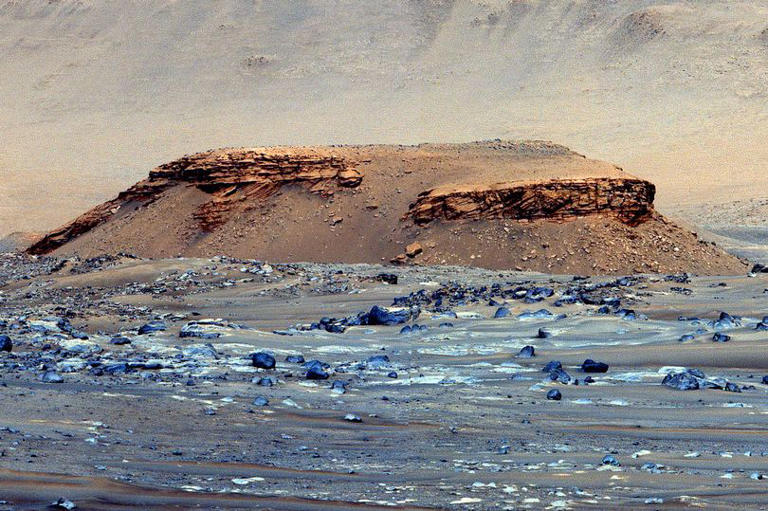Earth Mantle Discovery Expedition marks a groundbreaking moment in science as researchers drill 4,160 feet beneath the Atlantic Ocean to uncover a piece of Earth’s mantle, offering new insights into our planet’s origins and the processes that sustain life.

© Johan Lissenberg
Earth Mantle Discovery Expedition: A Groundbreaking Journey to the Depths
The Earth Mantle Discovery Expedition represents a monumental achievement in the field of Earth sciences. In a record-breaking mission, an international team of scientists led by the UK successfully drilled 4,160 feet beneath the Atlantic Ocean, recovering a piece of the Earth’s mantle for the first time. This incredible journey into the depths of our planet offers new perspectives on Earth’s geological history and could even provide clues about the origins of life.
A Record-Breaking Achievement
The Earth Mantle Discovery Expedition took place in Spring 2023 aboard the ocean drilling vessel JOIDES Resolution. The team, comprising scientists from over 30 countries, set out to explore a tectonic window along the Mid-Atlantic Ridge, where Earth’s tectonic plates converge, leading to volcanic activity. The mission’s success in retrieving a section of mantle rock is a historic milestone, as it marks the first time that scientists have accessed this deep layer of Earth’s structure directly from beneath the seabed.
Unveiling the Earth’s Mantle
The recovered rock sample offers a unique glimpse into the Earth’s mantle, the layer beneath the crust. This section of mantle rock, retrieved from the tectonic window, is of particular interest because it provides a continuous cross-section that can reveal the processes at work deep within our planet. The findings of the Earth Mantle Discovery Expedition could help scientists unravel the mysteries of how Earth’s crust formed and how the mantle has influenced the planet’s evolution over billions of years.
Surprising Scientific Discoveries
The Earth Mantle Discovery Expedition yielded surprising results. The analysis of the recovered mantle rocks, as published in the journal Science, revealed a more extensive history of melting than scientists had anticipated. The rocks contained lower amounts of the mineral pyroxene and higher concentrations of magnesium than expected. This suggests that the mantle underwent more significant melting processes as it rose toward the surface, challenging previous models of magma formation and volcanic activity.
The research team, led by Professor Johan Lissenberg from Cardiff University, was particularly intrigued by these unexpected findings. These findings could have major implications for understanding the processes that drive volcanism and the formation of magma on Earth.
Insights into the Origins of Life
Beyond its geological significance, the Earth Mantle Discovery Expedition also offers valuable insights into the potential origins of life on our planet. The research team explored how the abundant mineral olivine, found in the mantle rocks, interacts with seawater. This interaction triggers a series of chemical reactions that produce hydrogen and other molecules capable of sustaining life. Scientists believe that similar processes could have played a crucial role in the development of life on early Earth.
© Getty
Collaborative Efforts in International Science
The Earth Mantle Discovery Expedition exemplifies the power of international collaboration in advancing scientific knowledge. This mission, which brought together experts from more than 30 countries, highlights the importance of working together to achieve groundbreaking discoveries. The success of this expedition is a testament to the dedication and expertise of the scientists involved, who have collectively made a significant contribution to our understanding of the Earth’s inner workings.
Expedition 399, as it was officially named, focused on the “Building Blocks of Life” and was part of the International Ocean Discovery Program (IODP). The mission’s success reflects decades of effort, dating back to the early 1960s, when scientists first attempted to drill into the Earth’s mantle. The Earth Mantle Discovery Expedition has now set a new benchmark in the field, with its findings expected to influence research for years to come.
Future Implications of the Earth Mantle Discovery Expedition
The discoveries made during the Earth Mantle Discovery Expedition have far-reaching implications for our understanding of Earth’s geological processes. The data collected from the mantle rocks will provide new insights into the composition, behavior, and evolution of the Earth’s interior. These findings could lead to a better understanding of how magma forms, how tectonic plates move, and how volcanic activity shapes our planet’s surface.
Moreover, the research on the interactions between mantle rocks and seawater could offer new perspectives on the origins of life and the conditions that made Earth habitable. The chemical reactions observed in these rocks might mirror the processes that occurred billions of years ago when life first emerged on our planet. By studying these ancient processes, scientists hope to gain a deeper understanding of the factors that allowed life to flourish on Earth and the potential for life on other planets.
Conclusion: A New Frontier in Earth Sciences
The Earth Mantle Discovery Expedition marks a significant milestone in the field of Earth sciences. By successfully drilling 4,160 feet beneath the Atlantic Ocean and recovering a piece of the Earth’s mantle, scientists have opened a new frontier in our understanding of the planet’s deep interior. The unexpected findings from this expedition challenge existing models of magma formation and provide valuable insights into the processes that drive volcanic activity.
ALSO READ: